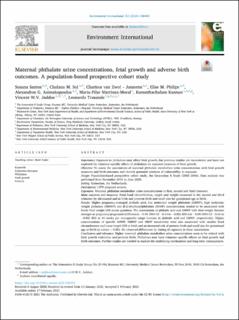| dc.contributor.author | Santos, Susana | |
| dc.contributor.author | Sol, Chalana M. | |
| dc.contributor.author | van Zwol – Janssens, Charissa | |
| dc.contributor.author | Philips, Elise M. | |
| dc.contributor.author | Asimakopoulos, Alexandros | |
| dc.contributor.author | Martinez-Moral, Maria-Pilar | |
| dc.contributor.author | Kannan, Kurunthachalam | |
| dc.contributor.author | Jaddoe, Vincent W.V. | |
| dc.contributor.author | Trasande, Leonardo | |
| dc.date.accessioned | 2023-01-16T12:05:48Z | |
| dc.date.available | 2023-01-16T12:05:48Z | |
| dc.date.created | 2021-11-26T12:19:14Z | |
| dc.date.issued | 2021 | |
| dc.identifier.citation | Environment International. 2021, 151 . | en_US |
| dc.identifier.issn | 0160-4120 | |
| dc.identifier.uri | https://hdl.handle.net/11250/3043695 | |
| dc.description.abstract | Importance
Exposure to phthalates may affect fetal growth, but previous studies are inconsistent and have not explored the trimester-specific effects of phthalates on repeated measures of fetal growth.
Objective
To assess the associations of maternal phthalate metabolites urine concentrations with fetal growth measures and birth outcomes and identify potential windows of vulnerability to exposure.
Design
Population-based prospective cohort study, the Generation R Study (2002–2006). Data analysis was performed from November 2019 to June 2020.
Setting
Rotterdam, the Netherlands.
Participants
1379 pregnant women.
Exposures
Maternal phthalate metabolites urine concentrations in first, second and third trimester.
Main outcomes and measures
Fetal head circumference, length and weight measured in the second and third trimester by ultrasound and at birth and preterm birth and small size for gestational age at birth.
Results
Higher pregnancy-averaged phthalic acid, low molecular weight phthalate (LMWP), high molecular weight phthalate (HMWP) and di-2-ethylhexylphthalate (DEHP) concentrations tended to be associated with lower fetal weight SDS across gestation. The associations of phthalic acid and LMWP with fetal weight became stronger as pregnancy progressed (differences −0.08 (95% CI −0.14 to −0.02) SDS and −0.09 (95% CI −0.16 to −0.02) SDS at 40 weeks per interquartile range increase in phthalic acid and LMWP, respectively). Higher concentrations of specific LMWP, HMWP and DEHP metabolites were also associated with smaller head circumference and lower length SDS at birth and an increased risk of preterm birth and small size for gestational age at birth (p-values < 0.05). We observed differences by timing of exposure in these associations.
Conclusions and relevance
Higher maternal phthalate metabolites urine concentrations seem to be related with fetal growth restriction and preterm birth. Phthalates may have trimester specific effects on fetal growth and birth outcomes. Further studies are needed to explore the underlying mechanisms and long-term consequences. | en_US |
| dc.language.iso | eng | en_US |
| dc.publisher | Elsevier | en_US |
| dc.rights | Navngivelse 4.0 Internasjonal | * |
| dc.rights.uri | http://creativecommons.org/licenses/by/4.0/deed.no | * |
| dc.title | Maternal phthalate urine concentrations, fetal growth and adverse birth outcomes. A population-based prospective cohort study | en_US |
| dc.title.alternative | Maternal phthalate urine concentrations, fetal growth and adverse birth outcomes. A population-based prospective cohort study | en_US |
| dc.type | Peer reviewed | en_US |
| dc.type | Journal article | en_US |
| dc.description.version | publishedVersion | en_US |
| dc.source.pagenumber | 0 | en_US |
| dc.source.volume | 151 | en_US |
| dc.source.journal | Environment International | en_US |
| dc.identifier.doi | 10.1016/j.envint.2021.106443 | |
| dc.identifier.cristin | 1959696 | |
| cristin.ispublished | true | |
| cristin.fulltext | original | |
| cristin.qualitycode | 1 | |

